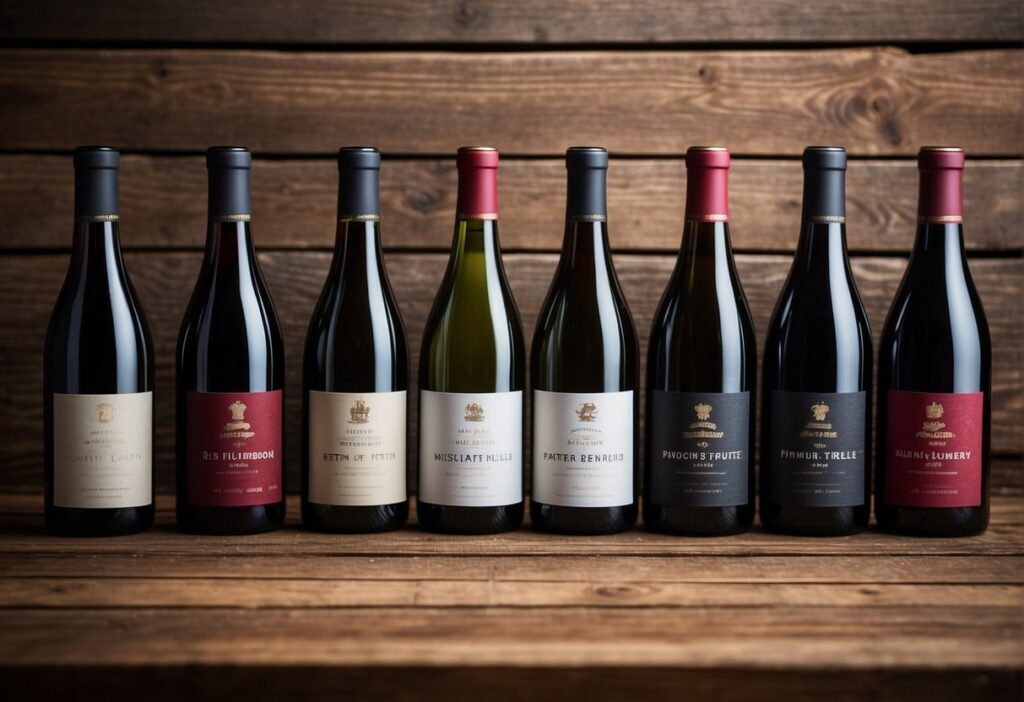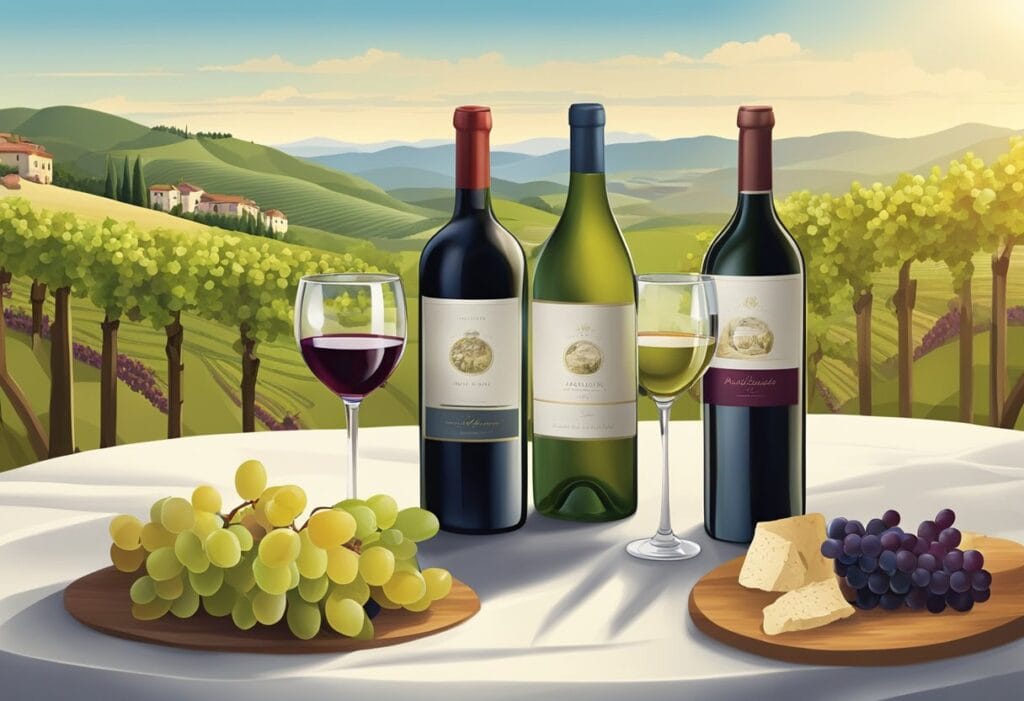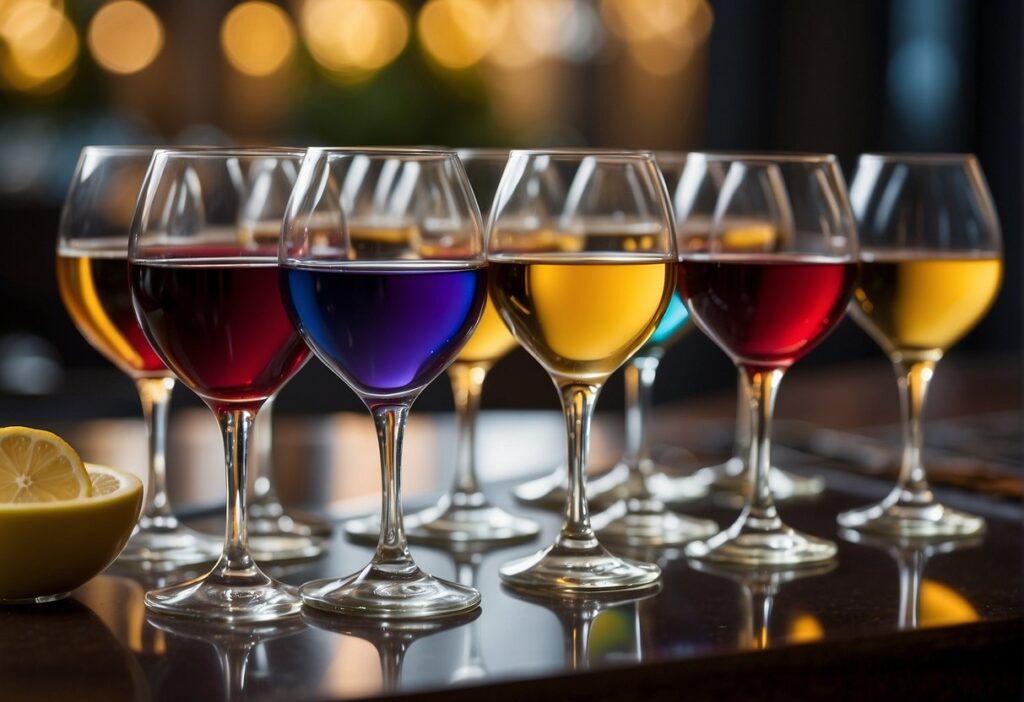Red wine is a beloved beverage that finds a special place on dinner tables and social gatherings around the world. With a range that spans from light and fruity to rich and full-bodied, red wines offer something for every palate.
Understanding the basics of red wine can enhance your appreciation and enjoyment of each glass.
The journey into the world of red wine begins with learning about the popular varieties, each with its own distinct flavor profile, and the regions where these grapes thrive.

Selecting the perfect red wine is an art that takes into account the occasion, food pairings, and personal taste preferences.
Whether you’re looking for a wine to complement a meal or seeking the right variety for a celebration, some knowledge helps in making an informed choice.
From the vineyard to your glass, the winemaking process also plays a crucial role in shaping the character of each wine.
As you explore different red wines, you’ll begin to discern the nuances that make this drink a complex and enjoyable experience.
Key Takeaways
- Understanding different red wine types can enhance enjoyment and pairing choices.
- The right red wine selection depends on occasion, food pairing, and flavor preference.
- Knowledge of the winemaking process adds depth to the appreciation of red wines.
Understanding Red Wine Basics
Red wine is a delightful journey through flavor and tradition. In this section, you’ll understand what red wine is and why the choice of grapes is integral to its character.
What is Red Wine?
Red wine, rich in both history and flavor, is made by fermenting the juice of dark-colored grapes.
During fermentation, the skins are kept in contact with the juice, imparting the wine with its characteristic deep hues, ranging from vibrant ruby to dense purple.
This process also imbues the wine with a complex array of flavors and aromas, from ripe red fruits to earthy undertones.
The acidity and tannins present in red wine are responsible for its mouthwatering zest and the dry, astringent feeling you might notice on your palate.
Tannins, which are naturally present compounds found in grape skins, seeds, and stems, also contribute significantly to the aging potential of red wine, allowing it to develop more nuanced flavors over time.
The Importance of Grapes
The type of grape determines much of a red wine’s character.
For instance, a Cabernet Sauvignon grape will yield a bold and robust wine, typically with high tannin levels that mellow as the wine ages.
A Pinot Noir, on the other hand, uses grapes that produce a light-bodied wine with lower tannin and a delicate flavor profile.
Each grape variety has its unique flavor and aroma profile, often reflecting the region where it’s grown.
Factors such as climate, soil, and topography, combined with grape type, work together to create a wine’s distinctive attributes.
This is why the grape is at the heart of red wine production and why your enjoyment of red wine begins with an appreciation of the grape itself.
Popular Red Wine Varieties
When exploring the world of red wines, you’ll find certain names that stand out on menus and wine lists. The varieties described here are staples in the wine community, each bringing its own flavor profile and charm to your palate.
Cabernet Sauvignon
Dubbed the king of red wines, Cabernet Sauvignon is renowned for its robust flavor and age-worthy qualities.
You can expect a full-bodied experience with prominent notes of blackcurrant and hints of cedar and spice.
A classic pairing choice for red meat, Cabernet Sauvignon excels in regions like Bordeaux and Napa Valley.
Experience the depth of this grape at Wine.com.
Merlot
Merlot stands out for its soft, velvety texture and approachable fruit flavors, often making it a favorite for those new to red wines.
Exhibiting flavors of ripe plums and cherries, it also has a touch less tannin than Cabernet Sauvignon, contributing to its easy-drinking character.
For a delightful introduction to Merlot, visit Delish.com.
Pinot Noir
The grape behind Pinot Noir is notoriously finicky, thriving in cooler climates like Burgundy and Oregon.
It serves up elegance in a glass—typically lighter in body but complex, with flavors of red berries, cherries, and often a subtle earthiness.
Select a Pinot Noir for your next meal when enjoying salmon or a mushroom-based dish.
Syrah/Shiraz
Whether you call it Syrah or Shiraz, this variety remains the same, although the style may differ depending on where it’s grown.
Syrah, as it’s known in France, offers more savory notes, while its Australian counterpart, Shiraz, tends to be jammier and more fruit-forward.
This hearty wine pairs brilliantly with barbecue and spicy dishes.
Zinfandel
Distinctly American, Zinfandel has a reputation for being a chameleon that can range from light and fruity to rich and full-bodied.
If you’re looking for jammy flavors with a peppery kick, Zinfandel is your go-to, especially alongside pizza or pasta with a robust sauce.
Red Wine by Region

When you explore red wines, you’ll find that each region offers unique varieties and styles shaped by local climates, terroirs, and winemaking traditions.
French Reds
In France, the Bordeaux region is celebrated for prestigious wines like Château Lafite Rothschild made from Cabernet Sauvignon and Merlot.
Burgundy, on the other hand, is known for its elegant Pinot Noir, especially from areas like Gevery-Chambertin Gevrey-Chambertin and Pommard.
Italian Reds
Italy offers an array of red wines with Tuscany’s famous Chianti and Brunello di Montalcino, primarily made from Sangiovese grapes.
The Piedmont region boasts robust Barolo and Barbaresco wines, derived from the Nebbiolo grape, which promise a distinct sophistication.
California Reds
Venturing to California, you’ll find the Napa Valley’s bold Cabernet Sauvignons, internationally renowned for their rich flavors.
Sonoma County, while also known for Cabernet, produces exquisite Zinfandel and Pinot Noir wines as well.
Australian Reds
Australia has made a name for itself with Shiraz, especially from regions like Barossa Valley and McLaren Vale.
These Shiraz wines are known for their fruity intensity and often have a hint of spice.
Other World Regions
Other notable regions include Spain with its full-bodied Tempranillo from Rioja and Ribera del Duero.
South American countries like Argentina, famous for its Malbec, and Chile, known for its exceptional value Cabernet Sauvignon, are also on your radar.
Let’s not forget Portugal, often overshadowed by its Port wines but also a source of excellent dry reds.
Understanding Red Wine Flavor Profiles

Red wine flavor profiles are vast and varied, offering you a range of tastes from the subtle to the bold. These flavors arise from the type of grape, the region it grows in, and the winemaking process itself.
Fruit Flavors
Red wines are typically characterized by their fruit flavors. These flavors can be broadly divided into:
- Red fruit flavors: Often found in lighter red wines, these can include cherry, strawberry, and raspberry.
- Black fruit flavors: Common in fuller-bodied red wines, these can bring notes of blackberry, plum, and blueberry.
The specifics of these flavors can vary with each wine, giving you a unique tasting experience every time.
Spices and Earthy Notes
Aside from fruit, red wines carry a panoply of spices and earthy notes.
You might detect a hint of black pepper or vanilla from oak aging. Other wines might have a flavor profile that includes:
- Earth or minerality, lending a sense of the terrain where the grapes were grown.
- Tobacco or leather notes, which can add a rustic, robust character to your glass.
- Complex sweetness of licorice or the subtle floral hint of violet, enhancing the wine’s bouquet.
Aging Influences
The aging process is crucial in developing red wine flavors:
- As red wines age, they acquire flavors such as vanilla, smoke, and chocolate, especially in oak barrels.
- With time, oak can also impart a touch of sweetness and toastiness to the wine.
The longer a wine ages, the more complex its profile becomes. Flavors like fig, leather, and earth become more pronounced.
Food Pairings with Red Wine

Selecting the perfect pairing can elevate your red wine experience. Certain foods bring out the wine’s rich and dynamic flavors.
Whether you prefer a bold Cabernet Sauvignon or a lighter Pinot Noir, understanding which foods to pair with your red wine will enhance both the drink and the meal.
Meat and Red Wine
Lamb: A classic pairing, the succulence of roast leg of lamb pairs brilliantly with the depth of a full-bodied red wine like a Cabernet Sauvignon. Meanwhile, duck and veal also match well with wines that have a fruitier profile, like Merlot.
- Pork: The subtle flavors of pork tenderloin are complemented by lighter red wines such as Pinot Noir. This highlights its savory notes without overwhelming the dish.
Cheese and Red Wine
When it comes to cheese, red wine is a natural companion. For strong cheeses like aged Cheddar or Gouda, opt for a wine that has enough character to stand up to the bold flavors, such as a Cabernet Sauvignon.
- Soft cheeses, on the other hand, can be enjoyed with lighter reds that balance the creaminess without overpowering them.
Vegetarian and Diverse Pairings
Pizza: A casual favorite like pizza, especially topped with gamey meats or robust vegetables, works well with an array of red wines. A classic Margherita pizza sings alongside a Chianti, while a pizza with a rich tomato sauce can handle a more robust Zinfandel.
- Vegetarian dishes with mushrooms or lentils offer an earthy flavor that pairs particularly well with red wines that have a note of savoriness, such as Dolcetto or Pinot Noir.
Selecting the Right Red Wine

When choosing a red wine, consider the wine’s body, tannin structure, sweetness level, and price to ensure you find a bottle that suits your personal taste and occasion.
Impact of Tannins and Body
Tannins contribute to the structure and dryness of a red wine. They can make your mouth feel dry after a sip.
The body of the wine, whether it’s light, medium, or full-bodied, indicates the overall feel in your mouth. Light-bodied wines are often more delicate, while full-bodied wines, rich in tannins, can offer a bolder and more robust experience.
Dry Versus Sweet Reds
The dryness of a wine refers to the absence of sugar, meaning a dry wine has no residual sugar and tends not to be sweet.
On the other hand, a sweet red wine has a noticeable sweetness to it, often enjoyed as a dessert wine. Your preference might change with the occasion, but knowing the distinction can guide your choice effectively.
Price Considerations
While you might assume that a higher price indicates higher quality, this isn’t always the case. You can find excellent wines at various price points.
Medium-bodied wines might offer a balance between value and complexity, making them a smart choice if you’re looking for an affordable yet satisfying option. Choose based on what fits your budget and matches the characteristics you enjoy.
Red Wine for Occasions

Whether you’re toasting a big achievement or simply enjoying a casual night in with friends, choosing the right red wine can elevate the moment. Let’s explore the perfect reds for every type of gathering you might host or attend.
Celebratory Reds
For milestone celebrations, pop open a bottle of Brunello. This Italian red brings elegance and depth to your toast, with its ripe fruit flavors and smooth tannins.
Another notable choice is Beaujolais Nouveau, a juicy and fatty wine released just in time for Thanksgiving that symbolizes festivity.
Casual Gatherings
When you’re hosting a laid-back affair, you want wines that are approachable and versatile.
A light and fruity Rose is perfect for sipping and socializing. It pairs well with a variety of dishes and sets a relaxed, friendly tone for the event.
Reds for the Connoisseur
If you’re looking to impress a wine aficionado, reach for a complex and bold red.
Offer a glass of aging-worthy Brunello, allowing your guest to appreciate the subtle nuances within each sip. For a connoisseur, the occasion itself is about savoring the wine’s journey from vine to bottle.
The Winemaking Process

Creating a fabulous red wine is both an art and a science. It intricately involves the fermentation of grapes, the patient aging process, and the winemaker’s deft touch. Let’s walk through the key stages that transform a simple grape into your favorite bottle of red wine.
Grape Fermentation
Fermentation is the heart of winemaking. After harvesting, your grapes are sorted, destemmed, and crushed—setting the stage for transformation.
The process relies on yeasts, which can be natural or selected strains, to convert the sugars in grapes into alcohol.
This stage typically spans about two weeks and involves careful oversight to shape the wine’s profile. Within the fermentation vessels, whether they be stainless steel tanks or open barrels, the grapes begin their journey, unleashing a range of complex aromatics.
Aging and Bottling
Once fermentation concludes, the nascent wine is not yet ready to meet your glass. It must undergo aging which can occur in stainless steel, concrete, or, more traditionally, in barrels made of oak.
The choice of container can impart various flavors and characteristics. For example, oak barrels can lend notes of vanilla and spice.
The duration of aging varies, ranging from several months to years. But it’s a vital period during which the wine develops greater complexity until it’s finally time to transfer the wine into bottles.
The Role of a Winemaker
In winemaking, your winemaker is both conductor and magician.
They possess deep knowledge of grape varieties and mastery over the fermentation process.
A winemaker’s decisions at every juncture dictate the wine’s final character.
They may choose to blend different lots for balance or to embrace a single grape’s pure expression.
Their intervention—or restraint—can result in the finely tuned composition of the red wine you love.
The winemaker oversees every detail, from the vineyard to the bottling, ensuring that every sip you take is the best it can be.

